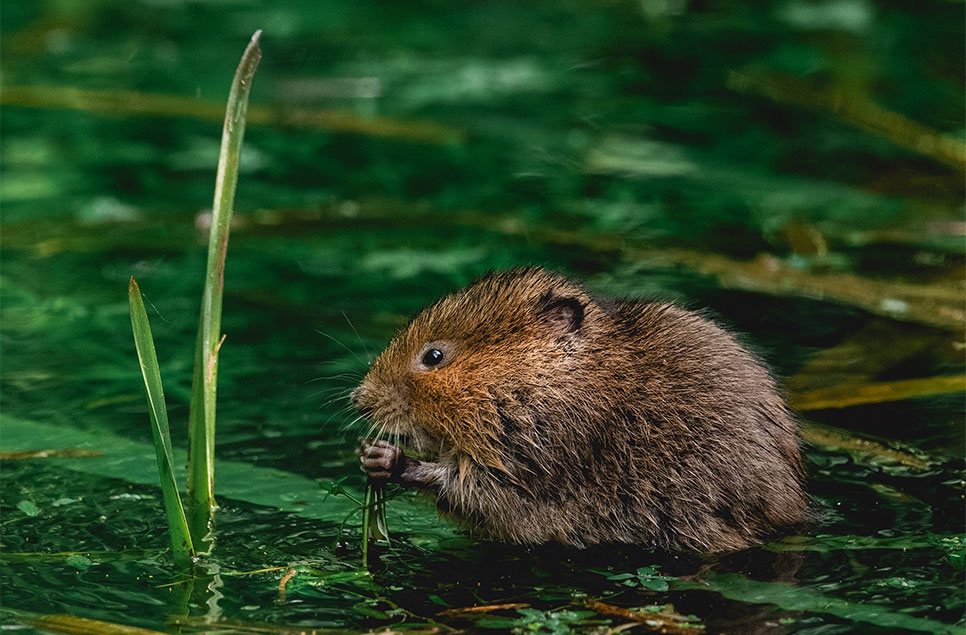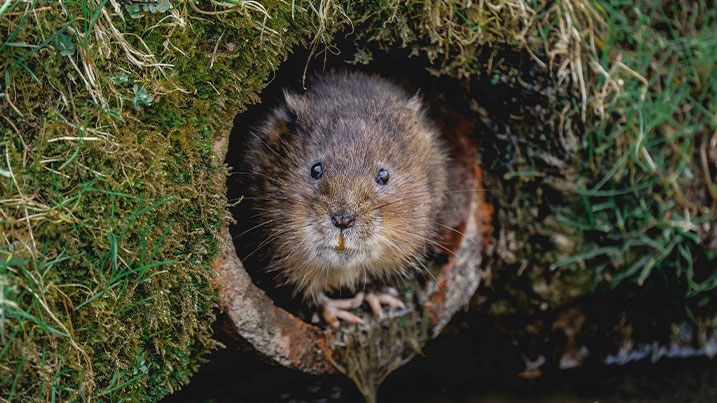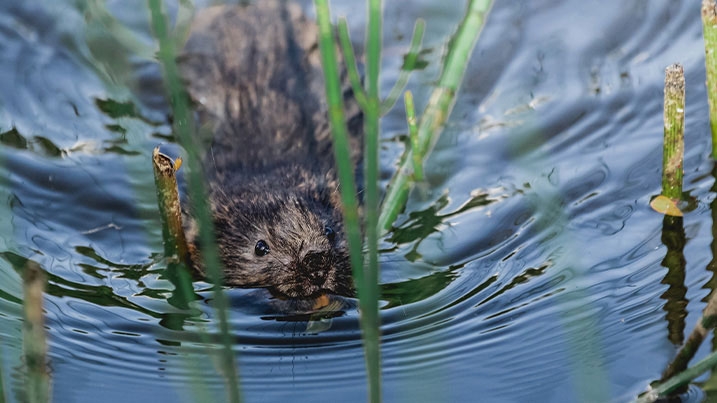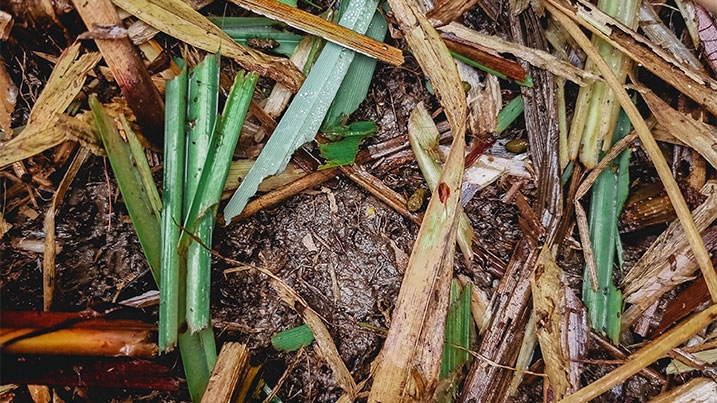10 top tips to spot a water vole
What can you do to increase your chances of spotting an endangered water vole?

Once a familiar sight, the endearing water vole is now few and far between. It’s now one of our fastest declining mammals. Since the 1970s its numbers have dropped by more than 90%. A result of loss of their wetland homes and attacks from invasive species like the American mink.
Follow our tips to see if you can get lucky and spot one of our shyest wetland inhabitants.
1. Look in the shallows
Despite their name, water voles aren’t particularly well suited to life on the water. Instead, you’ll find them in shallow water hugging the sides of rivers and other water bodies. If you’re lucky you might spot them peeping from riverbank nooks and crannies.
This is where, just below the water’s surface, they create bolt holes and entrances to their burrows. They build these by biting into the banks with their strong, orange teeth. Their burrows are usually the width of a Pringles tube and can be very complex and have two entrances, one on the bank and one underwater.

2. Use all your senses
Water voles aren’t particularly graceful swimmers. So, listen out for the characteristic ‘plop’ they make as they enter the water. This is them scrambling to get to their burrows and bolt holes and escape a would-be predator.
3. Scan the banks
Another tell-tale sign to look out for is ripples close to the riverbank. This can often be a sign of a water vole just below the surface. And when they’re actually swimming on the surface, they have a slow, doggy-paddle type stroke. This is definitely one of the loveliest sights to behold on a wetland visit.

4. Nibbled not gnawn
Look for vegetation that’s been cut off at a 45-degree angle. Water voles don’t tend to venture far from their burrows. So, chances are if you find a patch of nibbled grass near to the water’s edge, a water vole’s home won’t be far away.

5. Know your rat from your vole
‘Ratty’, the famous character from Wind in the Willows’ was actually a water vole. But despite this confusion, brown rats and water voles aren’t actually that similar.
Water voles have a round, blunt face, with small hidden ears. While brown rats have more pointy faces with visible pink ears. Water voles have short, brown, furry tails. A brown rat’s tail is long and pink and the full length of their body. Water voles are a deep brown, while brown rats are a lighter middling brown, with lighter underparts.
Despite their name, water voles are clumsy swimmers. They have neither the rudder like tail nor webbed feed that most other water loving creatures have. Brown rats on the other hand are good swimmers and unlike water voles won’t dive if alarmed.
6. Search out their latrines
The other thing that sets water voles apart from brown rats is their droppings. The water voles’ will be round and small and roughly the size of a tic tac. While brown rats leave groups of oval droppings. Look for the water voles’ piles of green-brown droppings that they leave near the water’s edge, known as ‘latrines’.
7. Time your visit
Water voles are busy during the day, when they spend most of their time eating out in the open. They need to eat up to 50% of their own body weight each day. They’re not picky about what they eat and have been recorded feeding on up to 220 different plants.
Their diet mostly consists of grasses and other waterside plants. But they’ll also eat twigs, bulbs, roots and fallen fruit. A pregnant water vole will even deviate from her usual vegetarian diet to eat caddisflies and water snails to boost her protein levels.
Water voles also spend their time during the day collecting grasses and reeds to take back to their burrows to stock up for the colder months.
8. A breeding frenzy
Breeding season for water voles starts in April and carries on until October. This is one of the best times of the year to see them as they’re tempted out of their hiding to find a mate.
They also become very territorial which also makes them easier to spot. They’re very tolerant of each other during the winter, often living together in their burrows in family groups. But come the breeding season that all changes, and they become very aggressive towards their neighbours.
There’s also more of them around at this time of year. With a gestation period of just 23 days, the female gives birth to between five and six litters a year, each with around three to five pups. This means one female water vole could have up to 30 babies in one season! The young leave the nest after just three weeks and are able to breed themselves at 15 weeks old.
Water voles need to be such efficient breeders to replace those lost during the winter, when up to 50% may die of starvation.
9. Patience is a virtue
As with all wildlife spotting, the best things come to those that wait. The water vole is notoriously shy, so you’ll increase your chances by watching quietly from a distance. You might find binoculars useful as you’re most likely to find them on the opposite riverbank from where you are.
10. Visit a WWT wetland centre
Water voles are thriving at many of our reserves and can be seen at a number of WWT sites, including London, Martin Mere, Slimbridge, Llanelli, Steart and Arundel.
WWT Martin Mere is lucky enough to have water voles on every ditch on the reserve. We survey them annually and thanks to our ditch management works, over the past five years water vole activity has doubled. Reserve Manager Louise Clewley recommends taking a canoe safari or a guided boat tour to see them:
‘As you paddle around in the peace and tranquillity amongst the reeds, look out for holes in the banks, latrines and feeding stations and listen out for their distinctive plop.’
At WWT Steart Marshes we have installed water vole rafts in some of the freshwater ditches across the reserve. The water voles use these platforms as feeding stations or territory markers. We’re then able to survey the rafts for their droppings and map their distribution across the reserve. We’ve even caught some footage of a water vole on one of our trail cameras.
We have a thriving community of water voles living at WWT Llanelli. Our Millennium Wetlands is now one of only two National Key Sites for water voles in Wales. We continue to work hard to protect and nurture these threatened creatures by creating the perfect wetland homes for them.
Surveys at WWT Arundel show we have water vole hotspots near the Scrape hide and the ditch at the Lapwing hide. Taking a ride in one of our electric boats, is also another great way to get up close and look for these lovable animals.
WWT London currently have a small number of water voles on site. Senior Reserve Warden, Callum Moore says to look for signs they’ve left behind like latrines on our wooden platforms along the channels, or grass eaten at their tell-tale 45-degree angle.
‘You’re most likely to spot a water vole from the paths along the South Route or in Wildside swimming along the vegetation.’
At WWT Slimbridge, thanks to careful management of our ditches, the length of bank used by water voles on the reserve went from just 250m to over 15 kilometres in just four years. We’ve just carried out our annual water vole survey, and evidence shows improvement on last year’s results already, with some very good strong holds for water voles across the reserve.
For the best chance of seeing one, our WWT Slimbridge Marketing Executive, Amy suggests taking a canoe safari and keeping an eye out for them around the Duck Decoy hide:
‘We’ve found piles of food and burrows near the decoy, so they’re known to be around that area.’
For more information on how to spot these elusive creatures our expert water vole trackers have put together this video for you:
If you’ve been inspired to explore one of our wetland centres and look for water voles yourself, find out more and plan your visit online:
Plan your visitAnd if you want to discover more about these precious animals, tune into our special water vole podcast episode. You’ll meet Jo Cartmell, who’s loved water voles since her childhood and has dedicated her life to monitoring and blogging about a group of voles who live in her village pond – even giving them names. While we find out why they’ve become so threatened and what we can do to help them.



